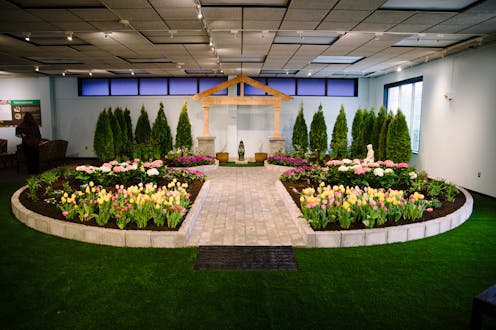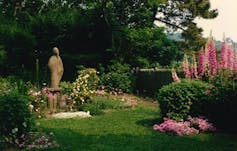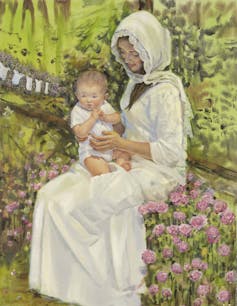‘Mary gardens’ bring Catholic piety to the garden
In the 20th century, an engineer from Philadelphia encouraged others to create their own Mary gardens and established a company that sold seeds with Marian plant names.

Each spring, some Catholics plant flowers around a statue of the Virgin Mary, reviving a tradition that goes back to medieval England when holy figures were remembered and shared through plant and flower names.
In Mary gardens, plants and flowers have specific Marian names or religious names in addition to their botanical and common names. For example, the plant today known as foxglove or Digitalis purpurea was once known as “Our Lady’s Glove.” Mary gardens also usually include a statue or image of Mary, sometimes holding the infant Jesus, as a focal point for devotion.
As librarians at the University of Dayton’s Marian Library, we curate collections about the Virgin Mary. One collection we study is from John S. Stokes, Jr., an engineer from Philadelphia who made it his life’s work to encourage others to create their own Mary gardens. With business partner Edward McTague, Stokes established the Mary’s Gardens company, which sold seed packets with Marian plant names in the 20th century.
Mary gardens in the United States

The first Mary garden in the United States is acknowledged to have been at St. Joseph’s Parish in Woods Hole, Massachusetts.
In 1929, Frances Crane Lillie, a parishioner of St. Joseph’s, gifted the parish two large stone bell towers and later developed a garden dedicated to the Virgin Mary on the tower grounds. Lillie had previously visited England, where she learned of the Mary garden tradition and felt inspired to recreate these beautiful gardens locally.
Frances’ husband, Frank, worked across the bay from St. Joseph’s Parish at the Marine Biological Laboratory. Frances wanted the bell towers and garden to be visible to her husband and the other scientists working at the lab. In a 1946 article for “Our Lady’s Digest,” she explained that the Mary garden was “to remind the scientists who study at the Marine Biology Laboratory across the street that there is another and valid aspect of life.”
John Stokes learned of the Mary garden at Woods Hole and felt called to research and restore these religious plant names to popular knowledge and encourage others to create their own Mary gardens as a form of devotion.
When England was Catholic, religious names for plants were commonly used – in fact, the kingdom itself was even known as “Mary’s England.” But the knowledge diminished in popularity after the Church of England split from the Catholic Church during the English Reformation.
Iconoclasm, or the rejection of religious imagery, is thought to be the reason for this decline. Although not artwork, the association of plants with holy figures was seen as a form of false worship or idolatry that the Reformation sought to reject.
Mary’s flowers and their legends

Using research from botanists, folklorists and lexicographers, Stokes and McTague created lists of hundreds of flowers and plants with their medieval, religious names. They tried to make Mary gardens accessible to all by curating lists based on climate and season and even suggesting dish gardens for those without an outdoor space.
Lavender, or Lavandula officinalis, is known today for the sweet, clean fragrance of its purple flowers. In the Mary garden tradition, lavender is referred to as “Mary’s Drying Plant.” As the legend goes, Mary washed the swaddling clothes from the infant Jesus and looked for a place to hang them to dry. She saw a lavender bush and spread out the clothes. When she returned, the clothes were dry from the wind and sunshine, and the bushes now had the pure sweet fragrant smell that was shared from Jesus’ clothes. This same story is attributed to other sweet-smelling shrubs, such as rosemary.
Germander speedwell, or Veronica chamaedrys, and Sea Thrift, or Armeria maritima, are both associated with the Holy Family’s flight into Egypt. Told in the Gospel of Matthew, after Jesus was born an angel appeared in a dream to Joseph and instructed him to go to Egypt with Mary and Jesus to escape Herod, a king who saw the infant as a threat. This scene is commonly depicted in art and in flower symbolism – the Germander speedwell is known as Our Lady’s Resting Place.
The journey from Bethlehem to Egypt was long and perilous, and it is said that the flower blossomed at each spot where the Virgin Mary rested along the way. Sea Thrift, or Sea Pink, with pink flowers that resemble a seat, is known as Our Lady’s Cushion and served as a place for her to sit while traveling.
Although it is not a far stretch to guess the Marian name of Marygold from the common marigold – Calendula officinalis – the legend associated with this flower is less clear. At the very least, it likely bloomed during feast days in honor of the Virgin Mary.
Like any folk tradition, there is some inconsistency in the Marian plant names and their history. More than one plant may be associated with the same legend or story, and not every plant has an apparent Marian name.
Although many might not know the full medieval history of Mary gardens, they are now a popular way for Catholics to practice their faith while connecting to nature.
The authors do not work for, consult, own shares in or receive funding from any company or organization that would benefit from this article, and have disclosed no relevant affiliations beyond their academic appointment.
Read These Next
Chile elects most right-wing leader since Pinochet – in line with regional drift, domestic tendency
José Antonio Kast, who has run for the presidency several times, successfully seized on widespread…
The ‘one chatbot per child’ model for AI in classrooms conflicts with what research shows: Learning
AI tutors are often held up as an ideal, but prioritizing individualized teaching can detract from the…
Getting peace right: Why justice needs to be baked into ceasefire agreements – including Ukraine’s
Just war theory, a centuries-old field of ethics, deals with how and when to start conflicts. It can…






